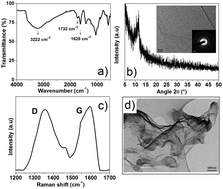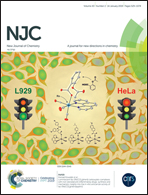UV-Induced reduction of graphene oxide in cellulose nanofibril composites
Abstract
We report on an effective dry method to reduce graphene oxide (GO) in films of cellulose nanofibrils (CNF) by UV irradiation in the presence of nitrogen gas. The reduction of GO and the removal of carbonyl and carboxyl moieties were confirmed by infrared and UV-vis spectroscopy, potentiometric charge titration and X-ray photoelectron spectroscopy (XPS). The crystallinity of native and reduced composites was elucidated by X-ray diffraction measurements. The resulting reduced graphene oxide–CNF nanocomposite films remain flexible and show improved dielectric properties. After 5 hours of UV irradiation a 3 wt% graphene oxide loaded film increased its dielectric constant from 68.9 to 88.9, which shows significant enhancement compared to previous reports. The AC conductivity of reduced GO films reaches values of 9.37 × 10−4 S m−1. The electrochemical performance of the samples was tested by cyclic voltammetry and electrochemical impedance spectroscopy. UV treated samples showed a higher capacitive nature than untreated samples. The UV induced reduction of GO in the presence of CNF is seen as a promising alternative to solvent based methods.



 Please wait while we load your content...
Please wait while we load your content...